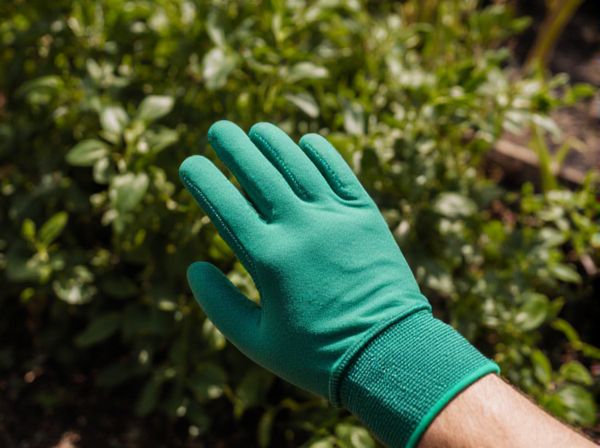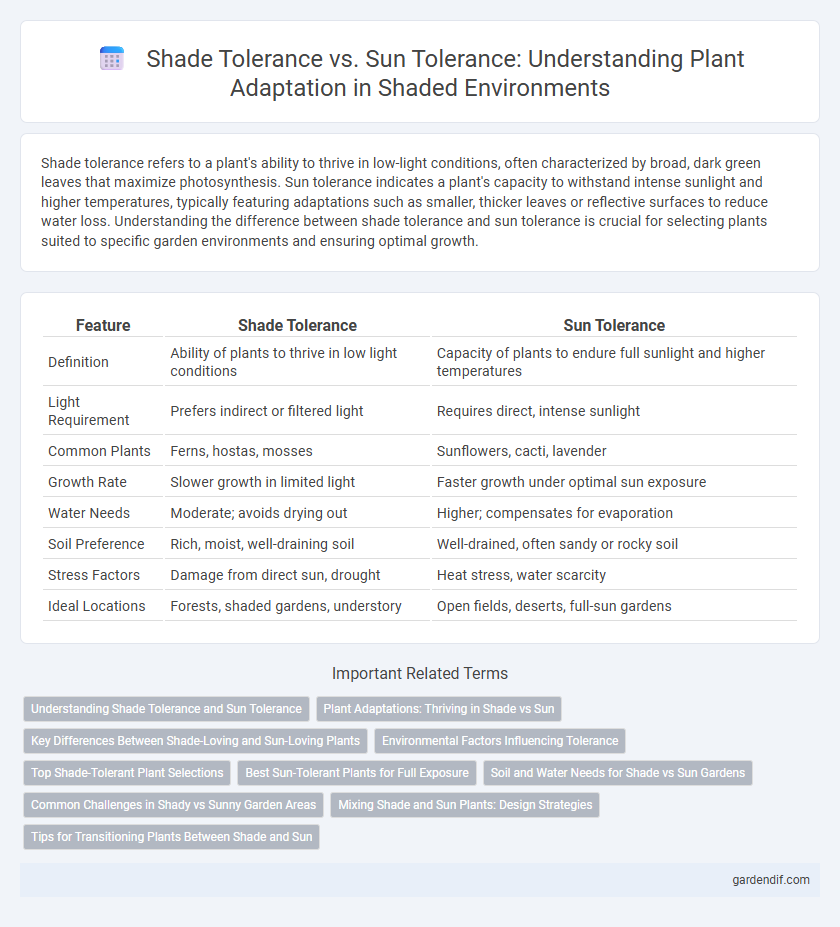
Shade Tolerance vs Sun Tolerance Illustration
Shade tolerance refers to a plant's ability to thrive in low-light conditions, often characterized by broad, dark green leaves that maximize photosynthesis. Sun tolerance indicates a plant's capacity to withstand intense sunlight and higher temperatures, typically featuring adaptations such as smaller, thicker leaves or reflective surfaces to reduce water loss. Understanding the difference between shade tolerance and sun tolerance is crucial for selecting plants suited to specific garden environments and ensuring optimal growth.
Table of Comparison
| Feature | Shade Tolerance | Sun Tolerance |
|---|---|---|
| Definition | Ability of plants to thrive in low light conditions | Capacity of plants to endure full sunlight and higher temperatures |
| Light Requirement | Prefers indirect or filtered light | Requires direct, intense sunlight |
| Common Plants | Ferns, hostas, mosses | Sunflowers, cacti, lavender |
| Growth Rate | Slower growth in limited light | Faster growth under optimal sun exposure |
| Water Needs | Moderate; avoids drying out | Higher; compensates for evaporation |
| Soil Preference | Rich, moist, well-draining soil | Well-drained, often sandy or rocky soil |
| Stress Factors | Damage from direct sun, drought | Heat stress, water scarcity |
| Ideal Locations | Forests, shaded gardens, understory | Open fields, deserts, full-sun gardens |
Understanding Shade Tolerance and Sun Tolerance
Shade tolerance refers to a plant's ability to thrive in low-light environments by efficiently utilizing limited sunlight for photosynthesis, while sun tolerance indicates a plant's capacity to withstand and flourish under intense, direct sunlight without experiencing stress or damage. Understanding shade tolerance involves recognizing adaptations such as larger, thinner leaves and slower growth rates that maximize light capture in shaded conditions. Sun-tolerant plants often possess features like thicker leaves, protective pigments, and robust water management systems to prevent dehydration and leaf scorch in high-light environments.
Plant Adaptations: Thriving in Shade vs Sun
Plants exhibiting shade tolerance develop larger, thinner leaves with increased chlorophyll to maximize light absorption under low-light conditions, enabling efficient photosynthesis. Sun-tolerant species adapt by having thicker leaves with protective features like waxy coatings and sunken stomata to minimize water loss and prevent photodamage in intense sunlight. These morphological and physiological adaptations allow plants to optimize energy capture and regulate water use according to their preferred light environments.
Key Differences Between Shade-Loving and Sun-Loving Plants
Shade-tolerant plants thrive in low-light environments by adapting to reduced photosynthesis through larger, thinner leaves and slower growth rates. In contrast, sun-loving plants require abundant sunlight for optimal photosynthesis, featuring smaller, thicker leaves to minimize water loss and faster growth rates. These key differences influence plant selection in landscaping, ensuring proper light conditions for healthy development and vibrant foliage.
Environmental Factors Influencing Tolerance
Shade tolerance and sun tolerance in plants are largely determined by environmental factors such as light intensity, temperature, and soil moisture levels. Shade-tolerant species have adapted to low light conditions by developing larger chloroplasts and thinner leaves to maximize photosynthesis, while sun-tolerant plants thrive in high light environments with thicker leaves and protective pigments to prevent damage from UV radiation. Soil quality and humidity also play critical roles, influencing water retention and nutrient availability, which further affect a plant's ability to tolerate varying light conditions.
Top Shade-Tolerant Plant Selections
Top shade-tolerant plants such as hostas, ferns, and astilbes thrive in low-light conditions by efficiently using available diffuse sunlight for photosynthesis. These species exhibit adaptive leaf structures and chlorophyll concentrations enabling them to perform well in shaded environments compared to sun-tolerant plants like lavender or sunflowers that require full sunlight exposure for optimal growth. Selecting shade-tolerant varieties enhances garden biodiversity and ensures healthy plant development in areas with limited direct sunlight.
Best Sun-Tolerant Plants for Full Exposure
Best sun-tolerant plants for full exposure include varieties such as lavender, sedum, and sunflower, which thrive under intense sunlight without wilting. These plants possess adaptations like thick, waxy leaves and deep root systems to minimize water loss and withstand high temperatures. Choosing sun-tolerant species ensures vibrant growth and prolonged blooming periods in environments with maximum sun exposure.
Soil and Water Needs for Shade vs Sun Gardens
Shade-tolerant plants require consistently moist, well-draining soils rich in organic matter to thrive in low-light conditions, as soil moisture retention is critical under canopy cover. Sun-loving plants demand soil with good drainage but may tolerate drier conditions and benefit from deeper watering to support higher transpiration rates in full sunlight. Water requirements for shade gardens tend to be more frequent but lighter, whereas sun gardens often need less frequent, deeper irrigation to sustain plant health and growth.
Common Challenges in Shady vs Sunny Garden Areas
Shade tolerance and sun tolerance in plants determine their growth success and stress adaptation in varying garden light conditions. Common challenges in shady areas include limited photosynthesis, increased moisture retention leading to fungal diseases, and reduced flowering, while sunny areas often face heat stress, dehydration, and soil nutrient depletion. Understanding these factors helps in selecting appropriate plant species to optimize garden health and aesthetics.
Mixing Shade and Sun Plants: Design Strategies
Mixing shade and sun plants requires selecting species with complementary light tolerances to optimize garden health and visual appeal. Shade-tolerant plants like hostas and ferns thrive under tree canopies, while sun-tolerant plants such as lavender and cone flowers demand at least six hours of direct sunlight. Strategic layering and zoning enhance microclimates, enabling successful coexistence and maximizing biodiversity in diverse light conditions.
Tips for Transitioning Plants Between Shade and Sun
Gradually acclimate plants when transitioning between shade and sun by increasing their light exposure over 7 to 14 days to prevent shock and leaf burn. Choose species with intermediate shade tolerance for easier adaptation and monitor soil moisture, as sun-exposed plants often require more frequent watering to reduce stress. Use protective measures like shade cloth during peak sunlight hours to shield sensitive plants while they adjust to their new environment.
Shade Tolerance vs Sun Tolerance Infographic

 gardendif.com
gardendif.com